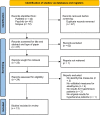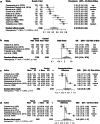Alexithymia and Hypertension: Does Personality Matter? A Systematic Review and Meta-analysis
- PMID: 37212924
- PMCID: PMC10307708
- DOI: 10.1007/s11886-023-01894-7
Alexithymia and Hypertension: Does Personality Matter? A Systematic Review and Meta-analysis
Abstract
Purpose of review: Personality characteristics, such as alexithymia, may lead to alterations in the autonomic nervous system functionality, predisposing individuals to an increased risk of hypertension (HTN). The present meta-analysis aimed to quantify the presence of alexithymia in people with HTN and to assess for potential sources of heterogeneity between studies. PubMed, PsycINFO and Scopus databases were systematically searched, using the following strings: ("alexithymia" OR "alexithymic") AND ("hypertension" OR "hypertensive"). Data were meta-analyzed with random-effects models.
Recent findings: A total of 13 studies met the inclusion criteria. The prevalence of alexithymia in people with and without HTN were obtained from 5 studies (26.3% vs 15.0%; pooling of odd ratios, 3.15 [95% CI, 1.14;8.74]), whereas the mean level of alexithymia between people with and without HTN was obtained from 7 studies Hedges g, 1.39 [95% CI, -0.39;3.16]). There was a significant association between alexithymia prevalence and year of article publication (ĝ = -0.04; 95% CI, -0.07;-0.01), whereas no significant relationship was detected between the former and both sex and age. Findings revealed a greater prevalence of alexithymia in people with HTN than in participants without HTN. These findings suggest that alexithymia may contribute to both the onset and persistence of HTN symptomatology. However, future research is needed to clarify this association.
Keywords: Alexithymia; Hypertension; Meta-analysis; Psychological factors; Systematic review.
© 2023. The Author(s).
Conflict of interest statement
All authors declare no conflict of interest.
Figures


References
-
- [Internet]. WHO: World Health Organization; 2022. Available from: https://www.who.int/health-topics/hypertension#tab=tab_1. Accessed 15 July 2022.
-
- Prugger C, Keil U, Wellmann J, De Bacquer D, de Backer G, Ambrosio GB, et al. Blood pressure control and knowledge of target blood pressure in coronary patients across Europe: results from the EUROASPIRE III survey. J Hypertens. 2006;29(8):1641–1648. doi: 10.1097/HJH.0b013e328348efa7. - DOI - PubMed
-
- Carretero OA, Oparil S. (2000). Essential hypertension: part I: definition and etiology. Circulation. 2000;101(3):329–35. 10.1161/01.cir.101.3.329. - PubMed
Publication types
MeSH terms
LinkOut - more resources
Full Text Sources
Medical
Research Materials
Miscellaneous

